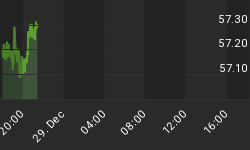The S&P 500 closed out the year at unchanged levels, while the SPY (S&P 500 SPDR) gained +1.89% due to its dividend payments.
The time frame between Christmas and New Year's Day has been surprisingly weak this year - despite the fact that the S&P 500 is up 0.85% month-to-date and 11.15% quarter-to-date - , including a 90%+ up and a 90%- down (1st time) volume day (volume associated with advancing | declining issues accounting for at least 90% of NYSE total volume).
But at least with respect to historical precedents, lopsided volume days (on both sides of the market) between Christmas and New Year's Day had significant short-term bullish implications in the past.
Table I below shows all occurrences (since 1965) and the S&P 500' performance (cumulative returns) over the course of the then following four sessions in the event one went long on close of a session where the S&P 500 had posted a 70%+ up or down volume day during the last three sessions of a year (16 occurrences up to now, in 14 years). The signal had already been (successfully) triggered on Wednesday, December 28, 2011.
Up to now, the S&P 500 shows a faultless track record of 16 higher (one unchanged) closes out of 16 occurrences two days later, calling for a ≥ +0.45% up day on Tuesday, January 3, the first session of the year. And although probabilities and odds for a higher close three and four days later are decreasing (but still 3 : 1 and 2 : 1 respectively), downside potential had always been limited (max. downside -1.28% over the course of the then following four sessions), indicating a low probability of significantly lower prices until Friday, January 6, 2012 (the S&P 500 is already down -0.43% since the signal had been triggered last Thursday).

A second (bullish) setup had been triggered on Friday, December 30, 2011 as well.
Although the S&P 500 is up 0.85% month-to-date and 11.15% quarter-to-date on December 30, 2011, the index performed poorly during the period between Christmas and New Year's Day.
Table II below shows all occurrences (since 1930) and the S&P 500' performance (cumulative returns) over the course of the then following four sessions, until the end of the then following week and until the 3rd Friday of January (OpEx since 1974) in the event the S&P 500 had been up month-to-date or up ≥ +4.50% quarter -to-date (in order to get a statistically significant sample size) on the final session of December, but posted a negative performance between Christmas and New Year's Day (long on close of the session immediately preceding Christmas Day, until the close of the last session of the year).
The S&P 500 closed at a higher level at all those points in time on 11 (12) out of 14 occurrences. In addition, downside potential had always been limited: the $SPX closed lower 1.0%+ on the end of the then following week on 2 occurrences only (on all other points in time listed below on 1 occurrence only), but up 1.0%+ on 11 or more occurrences.

Conclusion(s)
When the markets showed a strong performance during the month(s) preceding New Year's Day, but performed poorly between Christmas Day and the end of the year, or posted a 70%+ lopsided volume day on any side of the market during the last three sessions of a year, the S&P 500 showed a strong tendency to continue moving higher right at the start of the new year, indicating that the short- and intermediate-term trend will be (remain) up.
Have a profitable week, and I wish you a Happy New Year!
Disclosure: No position in the securities mentioned in this post at time of writing.
















